

|
Home Updates Hydros Cars Engines Contacts Links Racing Contact On The Wire |
|
|
Empty SpacesJim Free 1947-2019
|
Jim had the unique distinction of holding British tethered hydroplane records in five classes and four of them at the same time. The Novice and Super Novice class records, both held by him are now frozen, and the current B1 record is one of the longest standing, having been set by Jim in 2000 at 154.91mph. The B1R record was down to him as well, but he raised this several times when the class was renamed as B1S and it now stands at 128.48mph. His speciality with tethered hydros has been the airscrew classes, out and out racing, sport and vintage, but he was also dominant in the Novice Class, using the same boats to great effect in the A2 class at International meetings.
His high points were winning a gold
medal at Payre and being awarded the Subbotin Trophy at Chatellerault. With his Slipper and Flash boats he was a
regular competitor in vintage events as well, being a prolific trophy
winner. Apart from the involvement with tethered hydros,
Jim was a great collector and modeller spending a great deal of time building cars and boat using Jetex
and Estes rocket motors and specialist vehicles for the Tecno Games and
'Rocket league'. With one of these he managed to achieve over 200mph. A
long time member of the Blackheath Club and a regular at Victoria Park, he will be sadly missed.
On a personal note,
Jim was a great supporter of OTW throughout.
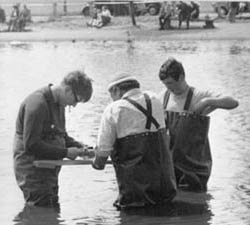 |
 |
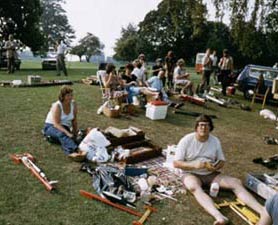 |
| Jim, Len and Norman Lara 1969 | St Albans 1970s | Jim and Sue St Albans 1984 |
Career in hydros:-
How
did you start in Hydro’s?
The first model that I built
when I was 9 was an Airfix, Spitfire, it was later in life that I
started to build and fly control line models. I joined the Blackheath
MPBC in 1964 and started my model boating interest (obsession) with a
series of straight running craft powered by both IC and electric motors.
I also dabbled in the early days of fast electrics. I started to get
serious about hydro's in the late 60's early 70's.
What
made you choose the B1 class(airscrew) to compete in?
I was inspired to start building
airscrew hydro's after reading about Mike Drinkwater's efforts in this
country, and reading in Model Boats Mag the reports of the high speed
obtained by the B1 class craft in international competition.
I was only producing very mediocre speeds at first until I met the then
French Champion Jean Marie Piednoir at St. Albans in 1978 who helped me
push my speeds from the high 90's to speeds of over 100mph. I then met
Hratcha Shahazizian in 1985 at the world champs in Holland, and then
Alexander Tupekin in 1987 in the world champs in East Germany, both
these guys were getting speeds of over 160+ mph when all around were
doing 130-140mph. It was with their help with engine set up and prop
technology that I set a new british record of just over 143mph in 1988
What
engines do you run?
It used to be Rossi but when
they stopped production I started to use Irvine in the open class B1,
and MDS 15 in the B1R class
Hulls, built to your own design, or based on someone else’s plan?
I look at other designs and
try and incorporate them into my own plans.
Which
win has given you the most satisfaction?
1988 in Welwyn
Garden City, all I heard was the time 7.2 sec, then I realised that I
had got the British record at 143 mph.
Do
you have an engineering background?
Yes, I took an apprenticeship
with Henry Sykes, makers of water pumps and attended College at
Woolwich, worked for Sykes from 63 to 81, then Head Lab Tech at Thames
Poly for four years.
Most
crucial element in getting a boat to go fast
Only make one alteration at a time, and careful
attention to detail.
Is there any boat you would
liked to have raced?
Bluebird, but failing that one
of Ken Hyder's, Slipper series of hydro's, the last one being
beautifully shaped, chrome yellow in colour and powered by a McCoy 60
engine
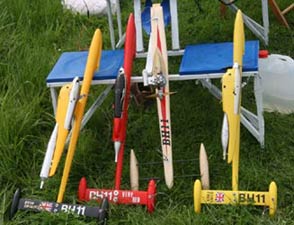 |
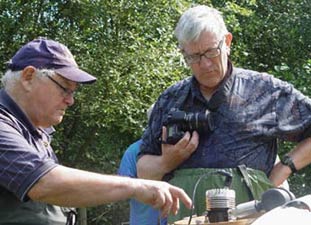 |
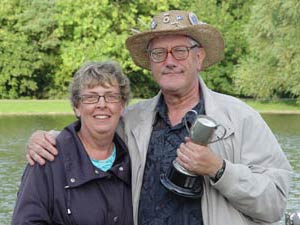 |
| Jim's B1s B1S and B1V | Jim the photographer with Tom Clement | Jim and Sue St Albans 2008 |
Jets and Things:-
Second to my usual day job of racing tethered hydro's I have had a long time interest in small reaction powered surface vehicles (boats and cars) powered by Jetex, Rapier, and low powered rocket motors (Estes and the like).
This fascination started at an early age when I was still at school and had joined the model making class at the evening classes there. The instructor was a big fan of Jetex powered models, mostly aircraft but he did build some boat and car models and it must have been that that started me on my interesting the subject. I remember in these early days before the jolly old HSE was around we used to run small tethered speed model aircraft, and in my case cars in the class room, you would not believe the amount of smoke a Jetex 50 produces in 15 seconds, but it was great fun. Well it was until the day when the motor came loose on one model and shot round the room like a demented squib this cleared the room in double quick time it also put pay to indoor jet, and car operations.
Time moved on and yours truly discovered that the Jetex Company produced several sizes of jet unit much larger than the little 50b size motor that at up to this time had powered all forms of boat and car model. These were the 150 PAA-LOADER, and SCORPION and it was that these motors that I stuck with for the rest of my adolescent (and adult) jet modelling escapades.
Over the years I suppose I have built dozens of models both published ones from the pages of Model Maker, and MECCANO magazine, and also the heady tomes such as The EAGLE Book of Balsa Models, Model Boats, and Model Cars.
Also many (too many?) of my own designs which I am still building to the present day that are still powered by many of my original motors. It’s quite amazing that even though Jetex have been out of production for many years tins of fuel and igniter wick in perfectly good working order can still be found at swap meets and toy fairs (never eBay too bloody expensive) to keep my toys running.
At one point not all that long ago when I thought it might be impossible to run the original Jetex motors due to, I thought at the time, the lack of suitable fuel I turned to the low powered miniature rocket motors produced by the ESTES Company in the USA these were much more powerful beasties that were capable of outputs of 3Kg of thrust, where the Jetex motors were only capable of thrust levels measured in grams, 180 at most, the big draw back with the rockets though was the very short thrust duration this being only 2-3 seconds. Enter the rocket car era.
The last 20 years or so of my working life I worked at a university located in Dartford, Kent. The great thing about this place was that it had extensive grounds, a very large sports ground great for model flying (two of my colleagues found this out very quickly), and a series of five tennis courts lined up side to side. Perfect for R/C cars, small tether cars, and in my case straight line rocket powered cars. In the summer months the courts were used for boring things like playing tennis (sad), but in the autumn and winter months the nets and other bits and pieces were stropped out leaving a very large and importantly flat area about 100 yds long.
|
The first of a series of rocket cars built using the bodies from two model rockets they proved to be very successful. The Rapid Rickshaw was quite a crude effort using a 1-1/14 inch dia cardboard tube and model aero wheels, and when finished resembled the Blue Flame land speed car. Purple Thing recorded a fastest speed of 1.6 sec for 35 metres. First runs were very encouraging using small B and C size motors speeds of around 50-60 mph being realised. Mods were made, ball raced knife edge wheels and parachute braking system (things were getting serious). |
|
I was also running on a straight line course using running line made from A2 class tethered hydro line. The car was attached to this by a guide system, the course length being about 120 yds diagonal distance. This time, fitted with a much larger D size motor, a staging system was used and when the car was run in this version I recorded my first 100 mph run timed by speed gun. The car was run several times after this recording speeds from about 98 to about 110 mph, however all things don’t run smoothly all the time and on it’s last run the motor decided it was going to be a weapon of mass destruction blowing the car into confetti.
Enter Techno Games.
I had watched two series of Techno Games on the tele, and was immediately drawn to the rocket car competition and thinking "I could do that", and so it came to pass yours truly built what was to be a very successful, if only to be a disappointing entry.
Filming was at Shepperton Studios the rocket car comp being filmed over one day. There were many entries so it was decided to run a four lane track so as to get through high numbers. I had made a purpose built car, (getting completely out of my tree) with the main body made from carbon/Kevlar composite, plasma welded stainless steel running gear, and light weight billet turned ball bearing wheels weighing under 120 grams complete with motor, a work of art even if I do say so myself. So imagine how I felt when we were all told that the minimum weight had been raised to 150 grams. After some hunting around I managed to get hold of some solder strip from one of the sparks on site, and with aid of some 5 minute epoxy soon had Rapid Rickshaw Mk4 up to spec.
|
The very serious cars. These two cars, the fastest cars that I produced using the old Techno Games rules. The un named yellow car was the one that achieved 200 mph. The other one Rapid Rickshaw 5 achieved 1.35 sec for 35 metres. |
|
|
The competition went quite well, very well in fact and I soon found my self in the final, but this was where disaster struck. All the launches up until this point were faultless, except this one. As the count down reached zero (all very dramatic in tale terms) all the motors in the other cars fired o.k. not mine though it decided just like the motor in the first car I built to be a small explosive device and completely blew the rear of the car to shreds. All I can say is that the kids in the audience thought I was great, I think I got more applause than the winner.
Not long after this one of the other competitors in the competition, Pete Barrett of the H.A.R.T model rocket club, informed me of the clubs rocket car league and invited me to run at their track. Imagine my surprise and amusement when I found that the track was yet at another school site and on disused tennis courts deja vu or what. Some good times were had there and it was at this place that I recorded my fastest ever speed, a fraction over 200 mph. The car was purpose built to go fast, made from carbon and glass fibre it weighed 180 grams and was powered by an Aerotech motor with a thrust of some 8 kilograms, a power to weight ratio of 45 to 1, no wonder it went quick.
All things come to an end and the school decided it wanted its tennis courts back to build something or other on so bye, bye rocket league. That all took place some eight to ten year ago and I soon went back to my roots to start to build small jet powered hydroplanes powered by original Jetex motors. I was lucky to find very large amount of fuel and igniter fuse for these at a local swap meeting for not much money (very important). I also used the newly introduced Rapier Jet motors that had come onto the market in three different thrust ranges.
|
The cars were all great fun to build and run, but my roots were always in the model boat world and to this end the design and building of small jet powered hydro's has always given me great pleasure. The Hydro Jet. This is the second of these models that I built; the first one was powered by a reproduction JETEX 350 motor that was fuelled with Scorpion pellets, the problem was that I completely under estimated the power of this motor and on its first outing it was totally destroyed as it slammed into pond side at some stunning speed. The second version, powered by a JETEX SCORPION motor; it is a lot lighter, and with another 1oz of thrust goes a long way in a short time. Speed about 25mph. As I understand it, this was the largest of the published designs. |
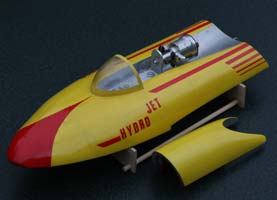 |
Jim spent nearly fifty years mastering the art of launching an airscrew hydro, something he achieved to great effect on many occasions.
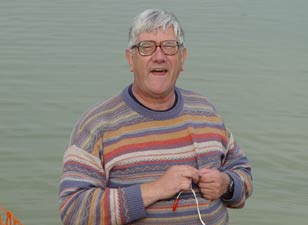 |
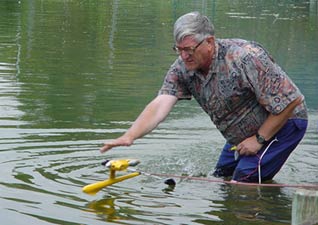 |
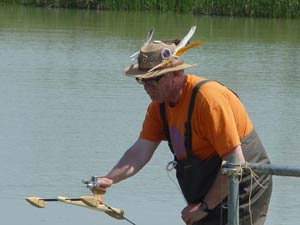 |
©copyrightOTW2020